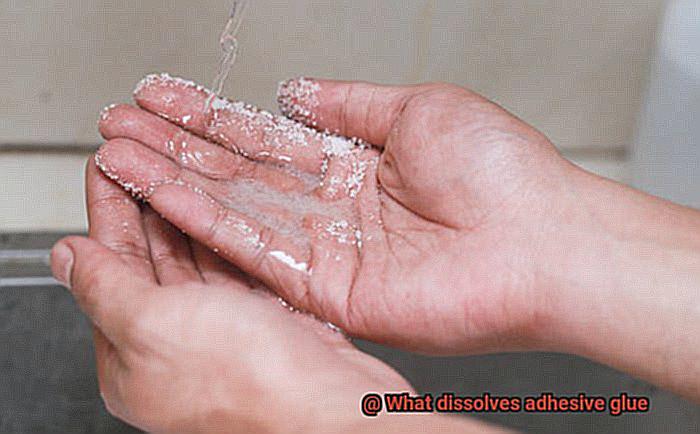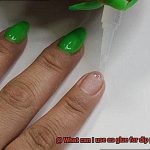Imagine this: you’re faced with that stubborn sticker residue mocking you on your newly bought treasure, or worse, you accidentally glue-bombed your favorite shirt. Ugh, talk about a sticky situation.
Today, we’re diving headfirst into the enchanting realm of adhesive glue dissolution. Prepare yourself for a mind-blowing adventure where chemical wizards reign supreme and mighty solutions await to effortlessly melt away any sticky challenge.
From everyday pantry heroes to jaw-dropping scientific secrets, we’ve got your back.
So buckle up as we embark on this liberating journey to bid farewell to adhesive glue forever.
What is Adhesive Glue?
Contents
- 1 What is Adhesive Glue?
- 2 Acetone: An Effective Solvent for Adhesive Glue
- 3 Rubbing Alcohol: An Alternative to Acetone
- 4 Citrus-Based Solvents: A Natural Way to Dissolve Adhesive Glue
- 5 Vinegar: Dissolving Water-Based Glues
- 6 Goo Gone: A Commercial Solution for Removing Adhesive Glue
- 7 Safety Precautions When Using Solvents to Dissolve Adhesive Glue
- 8 Conclusion
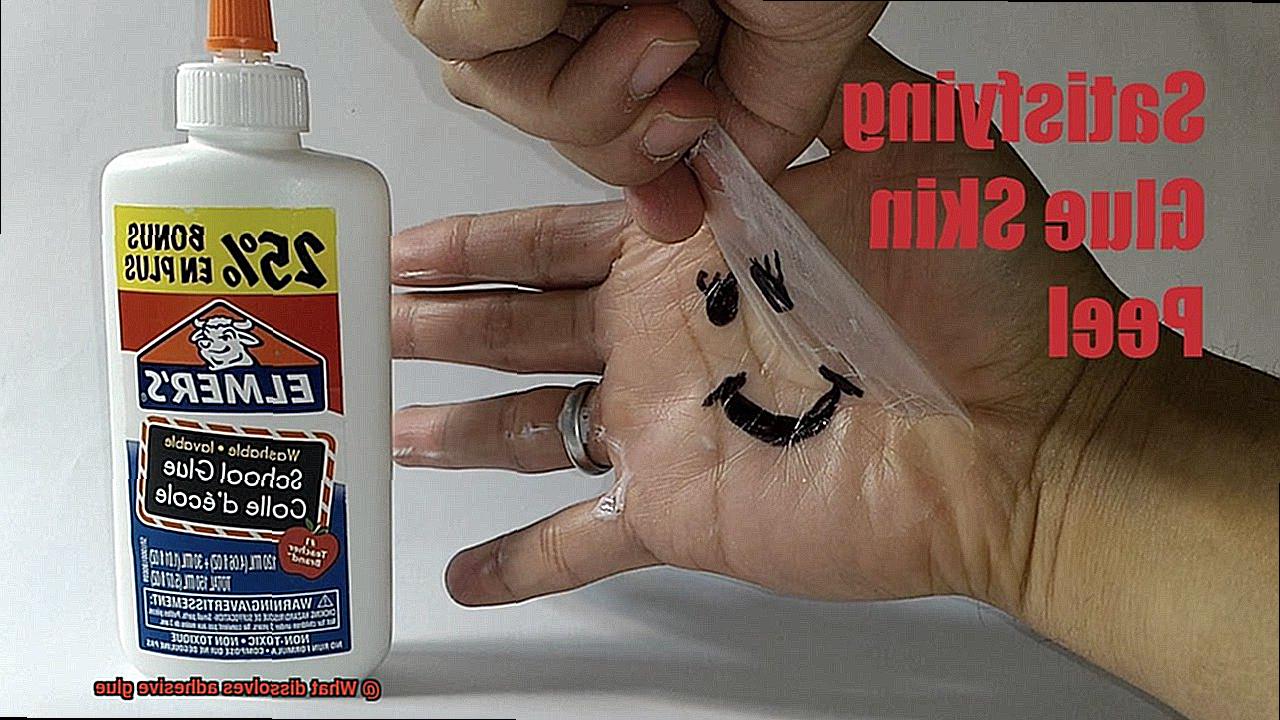
Adhesive glue, a humble yet extraordinary substance, is the unsung hero that binds our world together. From repairing broken objects to constructing towering structures, adhesive glue enables us to create, repair, and build with ease. In this article, we will delve into the fascinating realm of adhesive glue, exploring its purpose, function, and diverse applications.
The Marvels of Adhesion:
At its core, adhesive glue is all about adhesion – the art of sticking two surfaces together. But how does it work? Adhesive glues achieve this through a dance of physical and chemical interactions. When applied, the glue seeps into microscopic irregularities on the surface, creating a mechanical grip.
Simultaneously, chemical bonds form between the glue and surface molecules, forging an unbreakable connection. This harmonious blend of physical and chemical forces produces an incredibly robust bond.
A Tapestry of Types:
Just as there are different materials and applications in our world, adhesive glues come in various forms tailored for specific needs. Wood glue, super glue, epoxy, and fabric glue are some common examples. Wood glue boasts mighty adhesion for woodworking projects while resisting the onslaught of moisture. Super glue bonds swiftly to a wide range of materials like metal and plastic with Herculean strength.
Epoxy glue constructs resilient bonds on surfaces such as metal, glass, and plastic. Fabric glue ensures fabrics remain steadfastly joined in the textile and garment industries.
Unleashing the Possibilities:
The applications of adhesive glues span across industries like a vast tapestry. In woodworking, it fortifies joints in furniture and cabinetry with unwavering support. In construction, it wields the power to unite building materials such as concrete blocks or tiles with seamless precision. The automotive industry relies on adhesive glues to assemble vehicles more efficiently while simultaneously reducing weight.
Electronics benefit from adhesive glues for securing components and ensuring secure electrical connections. Packaging industries utilize adhesive glues to seal boxes and affix labels with unwavering tenacity. Even arts and crafts enthusiasts rely on the magic of adhesive glue to bring their creative visions to life.
The Art of Bond Strength:
Several factors influence the strength and effectiveness of adhesive glue bonds. The type of glue used plays a pivotal role, as different glues possess varying properties and capabilities. Additionally, the nature of the surfaces being bonded matters, as smooth surfaces may require additional preparation for optimal adhesion.
Cleanliness, temperature, humidity, and curing time also impact bond strength, requiring careful consideration for optimal results. Unlocking the art of bond strength ensures the foundation for success.
Acetone: An Effective Solvent for Adhesive Glue
Adhesive glue is a versatile substance that finds its way into various industries and everyday tasks. Whether you’re a craft enthusiast, an artist, or someone who needs to fix broken items, understanding the power of acetone as a solvent for adhesive glue can be a game-changer. In this article, we will explore why acetone is the go-to solution for dissolving and removing adhesive glue.
The Power of Acetone:
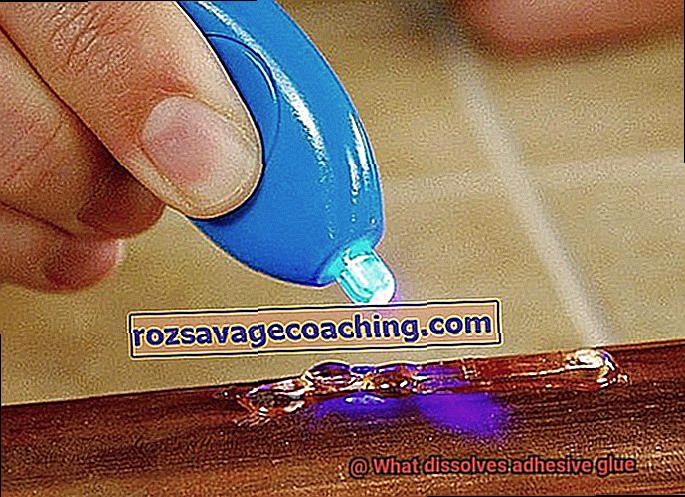
- Versatility: Acetone’s remarkable quality lies in its effectiveness on different types of glue. From stubborn super glue to sticky sticker residue, acetone can often tackle them all. This makes it the reliable choice for a wide range of applications.
- Chemical Breakdown: Acetone possesses the unique ability to break down the chemical bonds present in adhesive glue. When it encounters glue, it disrupts the cohesive forces holding it together, causing it to dissolve. This process allows for easy removal of sticky residues from various surfaces.
- Rapid Evaporation: Acetone’s low boiling point means it evaporates rapidly. This characteristic is advantageous when removing glue as it minimizes the risk of leaving behind residue. However, it’s important to work efficiently to prevent acetone from drying out before effectively dissolving the glue.
Using Acetone Safely:
- Surface Compatibility: While acetone is generally safe to use on many surfaces, caution must be exercised with certain materials like plastics or painted surfaces. Always perform a small patch test in an inconspicuous area before applying acetone to the entire surface.
- Ventilation and Protection: Working in a well-ventilated area is vital when using acetone due to its potentially harmful fumes if excessively inhaled. Additionally, wearing gloves can protect your skin from the drying effects of acetone.
- Proper Application: The recommended method for applying acetone to the affected area is using a cloth or cotton swab. Allow the solvent to sit for a few minutes to penetrate the glue before gently rubbing it away. Afterward, clean the surface with mild soap and water to remove any remaining residue.
Rubbing Alcohol: An Alternative to Acetone
Availability and Cost-Effectiveness:
Say goodbye to running around different stores in search of acetone. Rubbing alcohol can be found easily at your local drugstore or supermarket. No more hassle; just grab a bottle and you’re good to go. Not only is it readily available, but rubbing alcohol is also budget-friendly, making it the perfect solution for those looking for an affordable option.
Versatility and Effectiveness:
Rubbing alcohol is a superhero when it comes to tackling various types of adhesives used in crafts, hobbies, or home improvement projects. From stickers on glassware to residue on countertops, rubbing alcohol can effectively break down the adhesive without causing harm. It works by weakening the chemical bonds within the glue, giving you a clean and damage-free surface.
Simple Application:
Using rubbing alcohol couldn’t be easier. Just pour a small amount onto a clean cloth or cotton ball, and gently rub the affected area in circular motions. This allows the alcohol to penetrate the adhesive, loosening its grip. Depending on the strength and thickness of the glue, repeat the process until it is completely dissolved.
Safety Precautions:
Before diving into your project, take a moment to test rubbing alcohol on a small and inconspicuous area to ensure it won’t cause any damage or discoloration. Additionally, remember to wear gloves and work in a well-ventilated area due to the strong odor and potential skin irritation associated with rubbing alcohol.
Citrus-Based Solvents: A Natural Way to Dissolve Adhesive Glue
Struggling to remove adhesive glue from surfaces is a common annoyance. But fear not, there’s a natural and safe solution that can make this task a breeze. Enter citrus-based solvents, derived from oranges, lemons, and other citrus fruits. These solvents contain d-limonene, a powerful compound that effectively dissolves adhesive glue without the need for harsh chemicals. In this blog post, we’ll explore how citrus-based solvents work, their advantages, and how to use them properly.
The Power of D-Limonene:
Citrus-based solvents owe their effectiveness to d-limonene, a naturally occurring compound found in citrus fruit peels. It acts as a potent solvent, breaking down the adhesive properties of glue with ease. This natural alternative to traditional chemical solvents is not only effective but also environmentally friendly.

Advantages of Citrus-Based Solvents:
Using citrus-based solvents offers several advantages. Firstly, they are non-toxic, unlike harsh chemical solvents that emit harmful fumes and odors. This makes them safe to use in various settings. Additionally, these solvents are biodegradable, leaving minimal impact on the environment.
Using Citrus-Based Solvents:
Utilizing citrus-based solvents to dissolve adhesive glue is simple. Apply the solvent directly to the affected area and let it sit for a few minutes to allow it to penetrate the glue. This softens the glue, making removal a breeze. Gently scrape off the softened glue using a plastic scraper or a soft cloth. However, test the solvent on a small inconspicuous area first to ensure compatibility with the material.
Safety Precautions:
While generally safe for most surfaces, it’s always wise to wear gloves when handling citrus-based solvents to protect your skin from potential irritation, especially if you have sensitive skin. Additionally, proper ventilation is recommended to ensure a comfortable and safe environment when using any solvent.
Vinegar: Dissolving Water-Based Glues
Whether it’s a sticker on a glass jar or remnants of a crafting project gone wrong, water-based glues can be a challenge to dissolve. Luckily, there’s a secret weapon hiding in your pantry that can effortlessly tackle these sticky situations – vinegar. In this blog post, we’ll delve into the chemical properties of vinegar and explain how it can effectively dissolve water-based glues, making your clean-up tasks a breeze.
Decoding Water-Based Glues:
Water-based glues are commonly used in various applications, from woodworking to papercrafts. These glues are typically made from natural polymers like starch or cellulose, which are soluble in water. This solubility in water allows for easy clean-up when the glue is wet. However, once the glue dries and hardens, it becomes tenacious and challenging to remove.
Harnessing the Power of Vinegar:
Vinegar contains acetic acid, making it an exceptional natural solvent for dissolving water-based glues. Acetic acid has the remarkable ability to break down the polymer chains present in the glue, causing it to soften and release its grip on surfaces. This chemical reaction facilitates the removal of the glue without causing any damage to the underlying material.
Unleashing Vinegar’s Dissolving Magic:
To effectively utilize vinegar as a glue dissolver, begin by soaking the glued area in vinegar for a specific period of time. The duration may vary depending on the strength of the glue. During this soak, acetic acid penetrates the adhesive, gradually breaking down its bonds and rendering it pliable.
Gentle Removal Techniques:
After soaking, gently scrape off the softened glue using a scraper or cloth. Exercise caution to avoid scratching or damaging the surface while removing the glue. If necessary, repeat the soaking process and employ a soft scrubbing motion until all traces of the glue have been eliminated.
Considerations and Precautions:
It’s important to note that vinegar may not be effective on all types of water-based glues. Some glues may require stronger solvents or specialized adhesive removers. Additionally, vinegar has a potent smell, so it’s advisable to work in a well-ventilated area or consider wearing a mask if needed.
The Benefits of Vinegar:
Vinegar offers several advantages when it comes to dissolving water-based glues. Firstly, it is a safe and non-toxic option, making it preferable to certain commercial adhesive removers that contain harsh chemicals. Secondly, vinegar is readily available in most households and is an affordable solution for everyday use.
Goo Gone: A Commercial Solution for Removing Adhesive Glue
Look no further. In this article, we will explore the effectiveness of Goo Gone as a commercial solution for removing adhesive glue. Whether it’s tape residue, sticker residue, gum, or even tar, Goo Gone is here to save the day.
Exploring the Ingredients:
Goo Gone’s magic lies in its powerful combination of ingredients. At the heart of its formula is citrus oil, renowned for its exceptional solvent properties. This potent oil breaks down the adhesive bond, effortlessly dissolving sticky residue. Additionally, petroleum distillates in Goo Gone act as solvents, further aiding in breaking down the glue into a more manageable state. These ingredients work together harmoniously to ensure optimal performance.
Application and Usage Tips:
Using Goo Gone couldn’t be simpler. Apply the liquid directly onto the adhesive glue and let it sit for a few minutes. This allows the solvents to work their magic. Next, gently scrub the area with a clean cloth or sponge using circular motions to loosen the adhesive. Finally, wipe away the dissolved glue and any remaining residue with a clean cloth or paper towel. It’s that easy.
Surface Compatibility:
While Goo Gone is highly effective on most surfaces, caution is necessary when using it on delicate or sensitive materials. Test it on a small, inconspicuous area first to ensure compatibility. Surfaces like plastics, painted surfaces, or fabrics may require extra care.
Versatility and Alternatives:
Goo Gone isn’t limited to just one type of adhesive glue. It tackles various glues with ease, including tape residue, sticker residue, gum, tar, and more. But if you find yourself without a bottle of Goo Gone at hand, don’t fret. There are alternative methods and homemade solutions you can try. Rubbing alcohol, vinegar, baking soda paste, or even peanut butter can serve as solvents to dissolve and remove adhesive glue in certain situations.
Safety Precautions When Using Solvents to Dissolve Adhesive Glue
Tackling adhesive glue can be a sticky challenge, but with the right solvents, you can conquer it effortlessly. However, it is vital to prioritize safety when working with solvents to prevent accidents and protect your well-being. This comprehensive guide will provide essential safety precautions to follow when using solvents to dissolve adhesive glue, ensuring a safe and successful project.
Work in a well-ventilated area:
To safeguard against inhaling potentially harmful fumes, always work in a well-ventilated space. Enhance air circulation by opening windows or utilizing fans, creating a fresh and safe environment.
Wear protective gear:
Shield your skin, eyes, and respiratory system from solvent exposure by wearing protective gloves, goggles, and a mask. These simple precautions are crucial for maintaining your health and preventing any adverse effects.
Follow manufacturer’s instructions:
Each solvent possesses unique properties and requires specific handling procedures. To ensure safe and effective use of the solvent, carefully read and follow the instructions provided by the manufacturer.
Avoid ignition sources:
Take precautions to prevent potential fire hazards by keeping solvents away from open flames or sparks. Prior to starting your project, turn off any nearby ignition sources to minimize risks.
Keep solvents out of reach:
Ensure solvents are stored in a cool, dry place away from direct sunlight. Properly seal containers to prevent leaks or spills. Additionally, keep solvents out of reach of children and pets as they can be harmful if ingested or inhaled.
Take regular breaks:
When working with solvents for an extended period, it is important to prioritize self-care. Take regular breaks to allow your body to rest and recover from potential exposure, promoting overall well-being.
Proper disposal:
Adhere to local regulations when disposing of used solvents. Never pour them down the drain or discard them in regular trash bins. Safeguard the environment and prevent harm by following proper disposal methods.
Rinse and seek medical attention:
In case of accidental contact with solvents, act swiftly by rinsing the affected area with water. If necessary, seek immediate medical attention to address any potential health concerns.
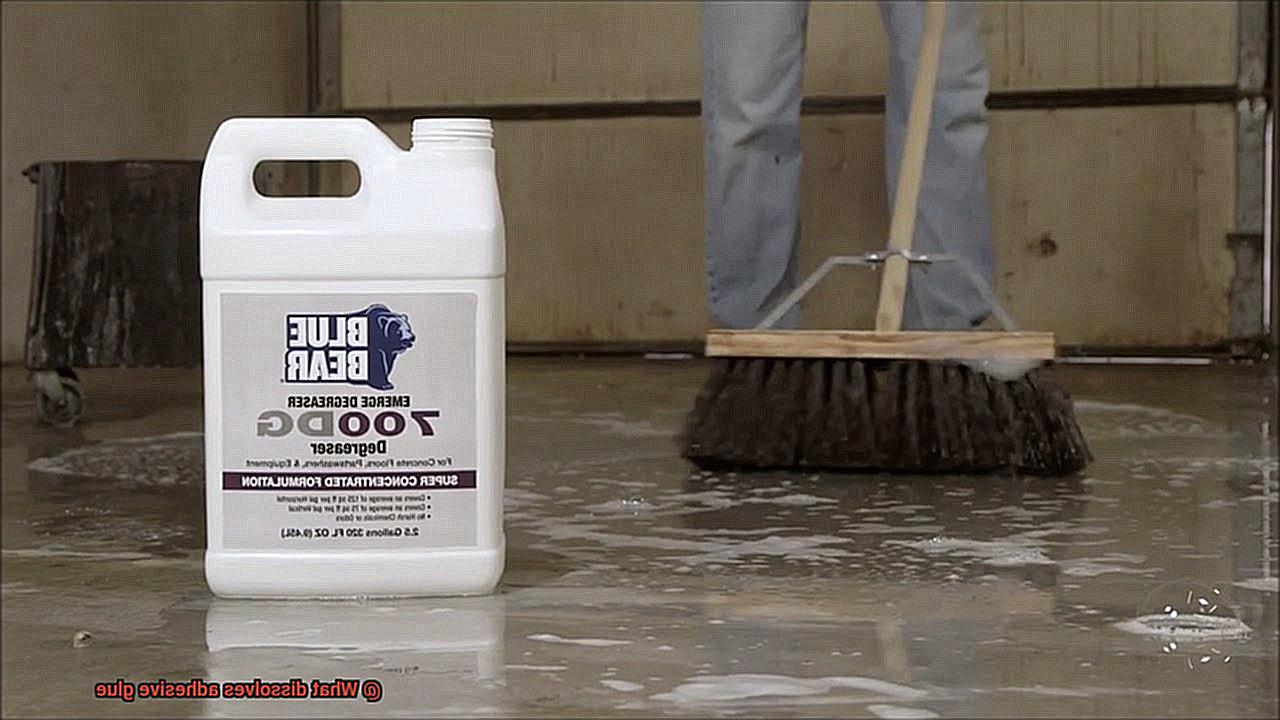
Have a fire extinguisher nearby:
Prepare for any unforeseen accidents or emergencies by having a fire extinguisher readily available when working with solvents. This proactive measure ensures that you are well-equipped to handle any unexpected situations.
_59ZzuLJcTw” >
Conclusion
In conclusion, removing adhesive glue can be quite the challenge, but fear not. There are a plethora of solvents and methods at your disposal to effectively dissolve and eliminate that stubborn stickiness. One such superhero in the world of adhesives is acetone. This versatile solvent packs a powerful punch when it comes to breaking down those pesky bonds. But remember, handle with care. Compatibility with different surfaces and proper ventilation are key.
If acetone isn’t your cup of tea, rubbing alcohol is here to save the day. This cost-effective and readily available alternative weakens those chemical bonds within the glue, making removal a breeze without causing any harm.
For those who prefer natural solutions, look no further than citrus-based solvents derived from oranges and lemons. These zesty wonders contain d-limonene, a magical compound that dissolves adhesive glue without resorting to harsh chemicals. Plus, they’re environmentally friendly and biodegradable.
When it comes to water-based glues, vinegar is the secret weapon you’ve been searching for. Its acetic acid content breaks down those polymer chains in the glue, leaving it soft and easy to remove. Affordable and found in most households, vinegar is a safe bet.
But if you’re looking for a commercial solution that means business, Goo Gone has got your back. With its potent combination of citrus oil and petroleum distillates, this powerhouse product can tackle adhesive glue on any surface.
Remember, safety first. When working with these solvents, always prioritize your well-being. Make sure you’re in a well-ventilated area and donning protective gear. Follow the instructions provided by the manufacturer and keep away from anything that could ignite them. And don’t forget about regular breaks and proper disposal of used solvents – they deserve some TLC too.
Armed with these solvent options and safety precautions in mind, you can confidently conquer any sticky situation that comes your way.

